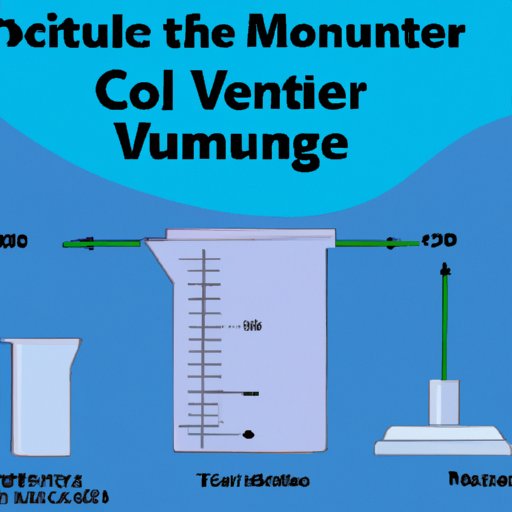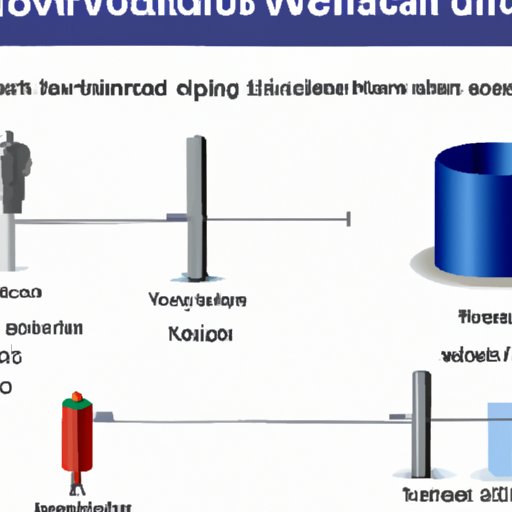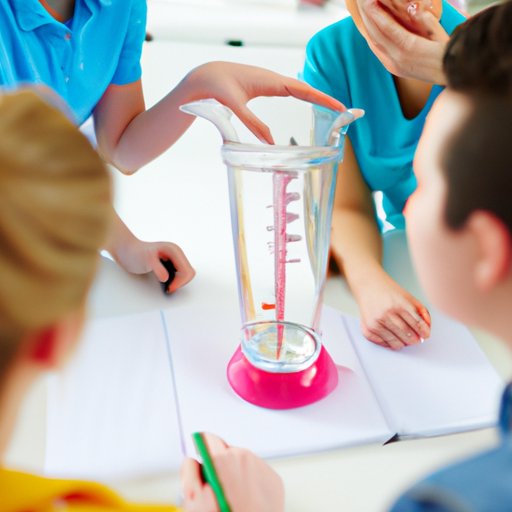Introduction
Volume is an important property in many scientific experiments and calculations. It is a measure of the amount of space taken up by an object or liquid, and it is typically expressed in liters, milliliters, or cubic centimeters. Knowing how to measure volume accurately is essential for scientists, engineers, and other professionals who need to make precise measurements. This article will explore the science behind volume measurement and the various instruments used to measure it.
Exploring the Science of Measuring Volume: A Look at Common Volume-Measuring Instruments
The science of measuring volume requires the use of specialized instruments that are designed to accurately measure small amounts of liquid or solid materials. There are several types of instruments available, each with its own advantages and disadvantages. Let’s take a look at some of the most commonly used instruments.
Different Types of Volume-Measuring Instruments
The most common type of instrument used to measure volume is the volumetric flask. Volumetric flasks are designed to measure a precise amount of liquid, usually between 10 mL and 1 L. Other types of instruments used to measure volume include graduated cylinders, pipettes, burettes, and beakers. Each of these instruments has its own unique design and purpose.
Examples of Commonly Used Instruments
Volumetric flasks are typically made of glass and have a long neck and a flat bottom. They are calibrated to hold a specific amount of liquid, which makes them ideal for measuring precise amounts of liquids. Graduated cylinders are also made of glass, but they have a cylindrical shape and markings on the side that indicate the volume of liquid inside. Pipettes are thin tubes with a bulb on one end that allows you to draw liquid into the tube and dispense it in precise measurements. Burettes are similar to pipettes, but they are larger and can measure larger volumes. Beakers are large containers with markings on the side that indicate the volume inside.
How to Accurately Measure Volume with Scientific Equipment
Accurate volume measurements require careful setup and calibration of the instruments being used. Before taking any measurements, all instruments should be properly calibrated and tested to ensure accuracy. Additionally, it is important to understand the limitations of each instrument and the factors that can affect accuracy. Here are some tips for taking accurate volume measurements.
Setting Up and Calibrating Instruments
Before taking any measurements, it is important to set up and calibrate the instruments being used. This includes cleaning the instruments and checking for any damage. Additionally, the instruments should be checked for accuracy using a certified calibration standard. This ensures that the measurements taken will be as accurate as possible.
Steps for Taking Accurate Volume Measurements
Once the instruments are set up and calibrated, it is time to take the measurements. The first step is to fill the instrument with the material being measured. For volumetric flasks, this means pouring the material into the flask until the calibration mark is reached. For graduated cylinders and beakers, this means filling the instrument until the desired level is reached. Once the instrument is filled, the volume can be read from the markings on the side.
An Overview of Scientific Instruments Used for Volume Measurement
Let’s take a closer look at the different instruments used to measure volume. Each of these instruments has its own advantages and disadvantages, so it is important to choose the right instrument for the job.
Volumetric Flasks
Volumetric flasks are designed to measure precise amounts of liquids. They are typically made of glass and have a long neck and a flat bottom. The neck is calibrated to hold a specific amount of liquid, which makes them ideal for measuring precise amounts of liquids. They are commonly used in laboratories for measuring and mixing chemicals.
Graduated Cylinders
Graduated cylinders are also made of glass, but they have a cylindrical shape and markings on the side that indicate the volume of liquid inside. They are used for measuring larger amounts of liquid, usually between 50 mL and 1000 mL. They are commonly used in chemistry labs for measuring out reagents and solvents.
Pipettes
Pipettes are thin tubes with a bulb on one end that allows you to draw liquid into the tube and dispense it in precise measurements. They are commonly used in biology and chemical labs for measuring small amounts of liquid, usually between 0.1 mL and 10 mL. They are also used in medical laboratories for measuring blood samples.
Burettes
Burettes are similar to pipettes, but they are larger and can measure larger volumes. They are usually used to measure volumes between 10 mL and 100 mL. They are commonly used in chemistry and biology labs for measuring and dispensing reagents and solutions.
Beakers
Beakers are large containers with markings on the side that indicate the volume inside. They are commonly used for measuring larger volumes of liquids, usually between 50 mL and 1000 mL. They are often used in chemistry labs for mixing and stirring solutions.

A Guide to Using Scientific Tools to Determine Volume
Now that we’ve explored the different instruments used to measure volume, let’s take a look at how to use each of these instruments correctly. Here are some steps for measuring volume with each instrument.
Steps for Measuring Volume with Volumetric Flasks
- Fill the flask with the material being measured.
- Check the calibration mark on the neck of the flask.
- Read the volume from the calibration mark.
Steps for Measuring Volume with Graduated Cylinders
- Fill the cylinder with the material being measured.
- Check the markings on the side of the cylinder.
- Read the volume from the markings.
Steps for Measuring Volume with Pipettes
- Draw the desired amount of liquid into the pipette.
- Check the calibration mark on the pipette.
- Read the volume from the calibration mark.
Steps for Measuring Volume with Burettes
- Draw the desired amount of liquid into the burette.
- Check the calibration marks on the side of the burette.
- Read the volume from the calibration marks.
Steps for Measuring Volume with Beakers
- Fill the beaker with the material being measured.
- Check the markings on the side of the beaker.
- Read the volume from the markings.
The Science Behind Measuring Volume: A Survey of Volume Measuring Equipment
In order to accurately measure volume, it is important to understand the factors that affect accuracy. These include temperature, pressure, and the viscosity of the material being measured. Additionally, it is important to understand the limitations of different instruments. For example, volumetric flasks are not suitable for measuring solids, while graduated cylinders are limited in their accuracy due to the markings on the side.

An Introduction to Volume Measurement: Understanding the Tools and Techniques Used
Choosing the right instrument for your needs is essential for taking accurate volume measurements. Different instruments have different advantages and disadvantages, so it is important to understand the capabilities and limitations of each instrument before making a decision. Additionally, it is important to consider the accuracy of the instrument, as well as the cost and availability of replacement parts.
Conclusion
Measuring volume accurately is an essential part of many scientific experiments and calculations. This article has explored the science behind volume measurement and the instruments used to measure it. We looked at the different types of instruments available and the steps for taking accurate measurements. Additionally, we discussed the factors that affect accuracy and the advantages and disadvantages of different instruments. By understanding the science behind volume measurement and the tools used to measure it, scientists and engineers can make more informed decisions when selecting the right instrument for their needs.
Summary of Key Points
- Volume is an important property in many scientific experiments and calculations.
- Common instruments used to measure volume include volumetric flasks, graduated cylinders, pipettes, burettes, and beakers.
- Accurate volume measurements require careful setup and calibration of instruments.
- It is important to understand the factors that affect accuracy and the limitations of different instruments.
- Choosing the right instrument for your needs is essential for taking accurate volume measurements.

Final Thoughts on Measuring Volume with Scientific Equipment
Measuring volume accurately is an essential skill for scientists, engineers, and other professionals who need to make precise measurements. By understanding the science behind volume measurement and the tools used to measure it, scientists and engineers can make more informed decisions when selecting the right instrument for their needs.
(Note: Is this article not meeting your expectations? Do you have knowledge or insights to share? Unlock new opportunities and expand your reach by joining our authors team. Click Registration to join us and share your expertise with our readers.)
